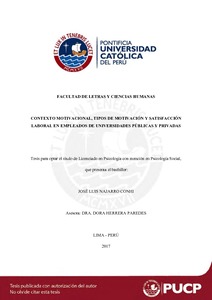| dc.contributor.advisor | Herrera Paredes, Dora Isabel | es_ES |
| dc.contributor.author | Najarro Conhi, José Luis | es_ES |
| dc.date.accessioned | 2017-11-13T16:46:33Z | es_ES |
| dc.date.available | 2017-11-13T16:46:33Z | es_ES |
| dc.date.created | 2017 | es_ES |
| dc.date.issued | 2017-11-13 | es_ES |
| dc.identifier.uri | http://hdl.handle.net/20.500.12404/9723 | |
| dc.description.abstract | La presente investigación se encarga de estudiar la asociación entre la percepción que posee el empleado sobre el nivel de promoción de autonomía del supervisor , tipos de motivación (autónoma vs controlada) y satisfacción laboral con variables sociodemográficas como el sexo, la edad, antigüedad laboral, puesto y salario. La muestra estuvo constituida por (N=316) trabajadores administrativos de universidades públicas (n=108) y privadas (n=198) de Lima Metropolitana. Los instrumentos utilizados fueron validados y adaptados a la realidad peruana;
estos fueron los siguientes: Cuestionario de Clima de Aprendizaje Revisado (Matos, 2015), Escala de
Motivación en el trabajo Revisado (Martin-Albo & Núñez, 2012) y la Escala de Satisfacción Laboral Revisada (Alarco, 2010). Los resultados indican que no hay diferencias al comparar promoción de autonomía, tipos de motivación y satisfacción laboral según sector de la organización (privada vs pública). No obstante, un trabajador que recién se ha insertado en su puesto de trabajo, presenta mayor motivación autónoma (μ= 6.33) que uno que lleva mayor tiempo trabajando o posee mayor antigüedad (μ= 4.5). De igual manera, se halló diferencias significativas en la motivación autónoma respecto a las diferentes categorías laborales; dicho tipo de motivación es mayor en el grupo de practicantes (μ M= 5.08) vs jefes (μ M= 3.22) y mayor también, al comparar practicantes con ejecutivos (μ M= 3.62). Ocurre lo mismo al comparar asistentes (μ M= 5.26) con ejecutivos. Finalmente, se descubrió que aquellos trabajadores menores de 30 años presentaban mayor motivación autónoma (μ=5.37) y satisfacción laboral (μ=3.19) que aquellos con mayor edad (μ=4.36 y μ=2.78, respectivamente). La relevancia del presente estudio radica en resaltar las variables importantes para un óptimo desarrollo del trabajador en la organización, sea esta pública o privada. Los hallazgos contribuyen a fortalecer la idea de que, en el país, las diferencias encontradas entre organizaciones pueden deberse más a factores
sociodemográficos y no tanto a la organización en sí. Respecto a las limitaciones, principalmente se encontró que las organizaciones aún no poseen un registro claro acerca de la relevancia de los aspectos psicológicos implicados en el trabajador y por tanto, su colaboración para desarrollar estudios nuevos es limitada. Para futuras investigaciones se sugiere ampliar el alcance del estudio incluyendo muestras más diversas y que tengan presente el bienestar de sus empleados. | es_ES |
| dc.description.abstract | This research aim is to analyze the association between supervisors’ autonomy support, types of motivation (autonomous vs. controlled) and job satisfaction and some sociodemographic variables such as gender, age, seniority, type of job and salary. The sample was composed by (N = 316) administrative workers of public and private universities (n = 108 and n = 198 respectively) of Lima. The applied psychological instruments were validated and adapted to the Peruvian context; these were: Learning Climate Questionnaire- Revised (Matos, 2015), Work Motivation Scale- Revised (Martin-Albo & Núñez, 2012) and Work Satisfaction Scale- Revised (Alarco, 2010). Results indicated that no differences appeared when comparing autonomy support, types of motivation and job satisfaction according to the organization's sector (private vs. public). However, a junior worker has more autonomous motivation (μ = 6.33) than a seniority one (μ = 4.5). Likewise, significant differences were found in the autonomous motivation about a group of practitioners (μM = 5.08) with heads (μM = 3.22) and practitioners with executives (μM = 3.62), as well as attendees (μM = 5.26) with executives. Finally, it was found that those workers younger than 30 years presented higher autonomous motivation (μ = 5.37) and job satisfaction (μ = 3.19) than those with older age (μ = 4.36 and μ = 2.78, respectively). The relevance of the present study was to make visible important variables for an optimal development of workers in organizations, whether public or private. Findings support the idea that, in the country, differences between organizations may be due to sociodemographic factors and not necessarily to the organization itself. Regarding the limitations, it was mainly found that the organizations still do not have a clear idea about the relevance of the
psychological aspects involved in the worker and therefore, their collaboration to develop new studies is limited. For future researches it is suggested to extend the scope of the study including more diverse samples and keeping in mind the employees’ well-being. | es_ES |
| dc.language.iso | spa | es_ES |
| dc.publisher | Pontificia Universidad Católica del Perú | es_ES |
| dc.rights | Atribución-NoComercial-SinDerivadas 2.5 Perú | * |
| dc.rights | info:eu-repo/semantics/openAccess | es_ES |
| dc.rights.uri | http://creativecommons.org/licenses/by-nc-nd/2.5/pe/ | * |
| dc.subject | Autonomía (Psicología) | es_ES |
| dc.subject | Motivación (Psicología) | es_ES |
| dc.subject | Satisfacción en el trabajo | es_ES |
| dc.subject | Empleados | es_ES |
| dc.title | Contexto motivacional, tipos de motivación y satisfacción laboral en empleados de universidades públicas y privadas | es_ES |
| dc.type | info:eu-repo/semantics/bachelorThesis | es_ES |
| thesis.degree.name | Licenciado en Psicología Social | es_ES |
| thesis.degree.level | Título Profesional | es_ES |
| thesis.degree.grantor | Pontificia Universidad Católica del Perú. Facultad de Letras y Ciencias Humanas | es_ES |
| thesis.degree.discipline | Psicología Social | es_ES |
| renati.discipline | 313066 | es_ES |
| renati.level | https://purl.org/pe-repo/renati/level#tituloProfesional | es_ES |
| renati.type | http://purl.org/pe-repo/renati/type#tesis | es_ES |
| dc.publisher.country | PE | es_ES |
| dc.subject.ocde | http://purl.org/pe-repo/ocde/ford#5.01.00 | es_ES |






